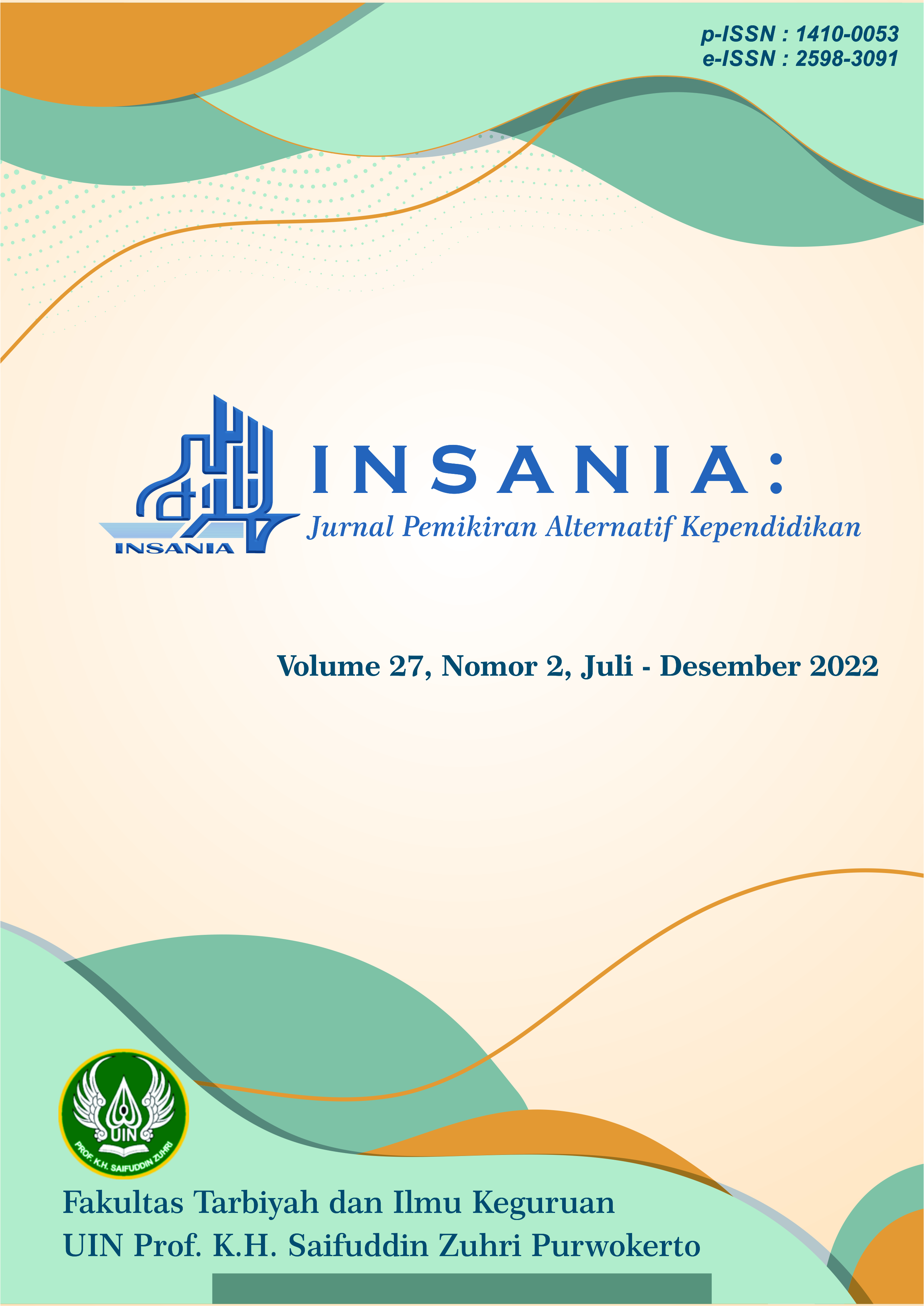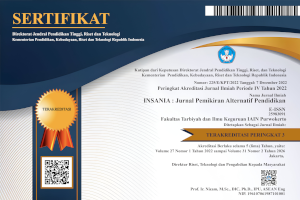Students' Perception on the Implementation of English Hybrid Classes in Islamic University and National University in Indonesia
DOI:
https://doi.org/10.24090/insania.v27i2.6787Kata Kunci:
students’ perception, hybrid classes, higher education, Covid-19Abstrak
Berbagai lingkungan belajar virtual telah diterapkan selama munculnya pandemi COVID-19. Pembelajaran hibrida adalah salah satu lingkungan belajar virtual di mana setengah dari siswa menghadiri kelas secara fisik sementara yang lain bergabung secara virtual. Model ini diadopsi oleh mahasiswa dari dua universitas yang berbeda di Jawa Tengah. Tujuan dari penelitian ini adalah untuk mengetahui persepsi mahasiswa tentang pembelajaran hibrida di dua universitas yang berbeda serta untuk mengetahui tantangan selama implementasi pembelajaran hibrida. Ada 87 peserta yang diambil sebagai subjek dari kedua universitas tersebut. Penelitian ini merupakan metode kualitatif yang menggunakan observasi dan angket untuk mengumpulkan data dari partisipan. Hasil penelitian menunjukkan bahwa siswa memiliki persepsi positif selama pembelajaran hibrida yang dapat mempengaruhi kinerja mereka. Persepsi positifnya adalah kelas hibrida menyediakan waktu yang fleksibel, peningkatan penguasaan teknologi, dan membangun interaksi sosial dengan orang lain. Selain itu, penelitian ini juga menemukan beberapa kendala seperti masalah teknis dan lingkungan atau lingkungan siswa yang telah mempengaruhi kinerja mereka. Kata Kunci: persepsi mahasiswa; kelas hibrida; Pendidikan tinggi; COVID-19Unduhan
Referensi
Alfiras, M., Nagi, M., Bojiah, J., & Serwani, M. (2021). Students’ Perceptions of Hybrid Classes in the Context of Gulf University: An Analytical Study. Journal of Hunan University Natural Sciences, 48(5), 180–188. http://jonuns.com/index.php/journal/article/view/588
Anderson, T. (2003a). Getting the Mix Right Again: An Updated and theoretical rationale for interaction. International Review of Research in Open and Distance Learning, 4(2). https://doi.org/10.19173/irrodl.v4i2.149
Benson, A. D. (2002). Using Online Learning To Meet Workforce Demand: A Case Study of Stakeholder Influence. Quarterly Review of Distance Education, 3(4), 443–452. https://eric.ed.gov/?id=EJ663220
Boelens, R., Wever, B. D., & Voet, M. (2017). Four Key Challenges to the Design of Blended Learning: A Systematic Literature Review. Educational Research Review, 22, 1–18. https://doi.org/10.1016/j.edurev.2017.06.001
Brown, A., & Voltz, B. (2005). Elements of Effective E-Learning Design. The International Review of Research in Open and Distance Learning, 6(1), 1–10. https://doi.org/10.19173/irrodl.v6i1.217
Carter, N., Bryant-Lukosius, D., Dicenso, A., Blythe, J., & Neville, A. J. (2014). The Use of Triangulation in Qualitative Research. Oncology Nursing Forum, 41(5), 545–547. https://pubmed.ncbi.nlm.nih.gov/25158659/
Estelami, H. (2012,). An Exploratory Study of the Drivers of Student Satisfaction and Learning Experience in hybrid-online and purely online marketing courses. Marketing Education Review, 22(2), 143–155. https://www.tandfonline.com/doi/abs/10.2753/MER1052-8008220204
Gironzetti, E., Lacorte M., & Munozbasols J. (2020). Teacher Perceptions and Student Interaction in Online and Hybrid University Language Learning Courses. In: Current Perspectives in Language Teaching and Learning in Multicultural Contexts. Thomson Reuters Aranzadi.
Gradel, K., & Edson, A. J. (2010-2011). Cooperative learning: Smart pedagogy and Tools for Online and Hybrid Courses. Journal of Educational Technology Systems, 39(2), 193-212. https://journals.sagepub.com/doi/10.2190/ET.39.2.i
Harris, P. R. (2004). An Overview of Online Learning (2nd ed.). European Business Review, 16(4), 430–430. https://doi.org/10.1108/09555340410561723
Juwita, R., & Purwoko, L. F. (2022). Design and Implementation of Hybrid Learning. International Journal of Educational Dynamics, 4(2), 14–23. https://doi.org/10.24036/ijeds.v4i2.340
Kerres, M., & Witt, C. (2003). A Didactical Framework for the Design of Blended Learning Arrangements. Journal of Educational Media, 28(2-3), 101–113. https://doi.org/10.1080/1358165032000165653
Kessler, G. (2018). Introduction to Teaching and Technology. The TESOL Encyclopedia of English Language Teaching, 1–2. https://doi.org/10.1002/9781118784235.eeltv06b
Kemendikbud. (2020). Surat Edaran Sekretaris Jenderal Kemendikbud Nomor 15 Tahun 2020 Tentang Pedoman Penyelenggaraan Belajar Dari Rumah Dalam Masa Darurat Penyebaran Corona Virus Disease (Covid-19).
Mahoney, K., & Cameron, L. (2008). An Introduction To Learning Management Systems. Reading in Education and Technology: Proceeding of ICICTE 2008, 8, 314–323.
Jackson, Mary Jo & M. Helms. (2008). Student Perceptions of Hybrid Courses: Measuring and Interpreting Quality. The Journal of Education for Business, 84(1), 7-12. https://doi.org/10.3200/JOEB.84.1.7-12.
Murray, M., Pérez, J., Geist, D., & Hedrick, A. (2013). Student Interaction with Content in Online and Hybrid Courses: Leading Horses to the Proverbial Water. Proceedings of the Informing Science and Information Technology Education Conference, 1, 99–115. https://digitalcommons.kennesaw.edu/facpubs/3437/
Muthuprasad, T., S. Aiswarya, K.S. Aditya, Girish K. Jha. (2020). Students’ Perception Preference for Online Education in India during COVID-19 Pandemic. Social Humanities & Humanities Open, 3. https://doi.org/10.1016/j.ssaho.2020.100101
Nashir, M., & Laili, R. N. (2021). Hybrid Learning as an Effective Learning Solution on Intensive English Program in the New Normal Era. IDEAS: Journal of Language Teaching and Learning, Linguistics and Literature, 9(2), 220–232. http://dx.doi.org/10.24256/ideas.v9i2.2253
Prihadi, S., Sajidan, S., Siswandari, S., & Sugiyanto, S. (2021). The Challenges of Application of The Hybrid Learning Model in Geography Learning During The Covid-19 Pandemic. GeoEco, 8(1), 1. https://doi.org/10.20961/ge.v8i1.52205
Rakhmanina, L., Martina, F., Halolo, F. B., Syafryadin, S., & Noermanzah, N. (2020). Students’ Perception on Online English Learning during Covid-19 Pandemic Era. Jurnal Penelitian Pendidikan Bahasa Indonesia, Daerah dan Asing, 3(2), 428–439 . https://ojs.stkippgri-lubuklinggau.ac.id/index.php/SIBISA/article/view/1150
Satori, D. & Komariah, A. (2013). Metodologi Penelitian Kualitatif. Alfabeta.
Sintema, E. J. (2020). Effect of COVID-19 on the Performance of Grade 12 Students: Implications for STEM Education. Eurasia Journal of Mathematics, Science and Technology Education, 16, 1-6. https://doi.org/10.29333/ejmste/7893
Syynimaa, N. (2018). Teaching on Hybrid Courses: Insights from Commercial Online ICT-Training. Proceedings of the 10th International Conference on Computer Supported Education, 253–258. https://doi.org/10.5220/0006701302530258
Thamrin, T., Hutasuhut, S., Aditia, R., & Putri, F. R. (2022). The Effectiveness of the Hybrid Learning Materials with the Application of Problem Based Learning Model (Hybryd-PBL) to Improve Learning Outcomes during the COVID-19 Pandemic. IJORER: International Journal of Recent Educational Research, 3 (1), 124–134. https://doi.org/10.46245/ijorer.v3i1.178
Zainuddin, Z., & C. M. Keumala. (2018). Blended Learning Method Within Indonesian Higher Education Institutions. Jurnal Pendidikan Humaniora, 6(2), 69–77. http://journal.um.ac.id/index.php/jph/article/view/10604
Unduhan
Diterbitkan
Cara Mengutip
Terbitan
Bagian
Lisensi
Hak Cipta (c) 2022 Gigih Ariastuti Purwandari, Eka Dyah Puspita Sari, Indah Puspitasari

Artikel ini berlisensiCreative Commons Attribution-ShareAlike 4.0 International License.
Authors who publish with this journal agree to the following terms:
Authors retain copyright and grant the journal right of first publication with the work simultaneously licensed under a Creative CommonsAttribution-ShareAlike License that allows others to share the work with an acknowledgment of the work's authorship and initial publication in this journal.
Authors are able to enter into separate, additional contractual arrangements for the non-exclusive distribution of the journal's published version of the work (e.g., post it to an institutional repository or publish it in a book), with an acknowledgment of its initial publication in this journal.
Authors are permitted and encouraged to post their work online (e.g., in institutional repositories or on their website) prior to and during the submission process, as it can lead to productive exchanges, as well as earlier and greater citation of published work (See The Effect of Open Access).









